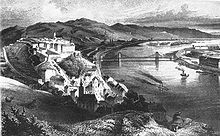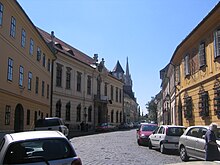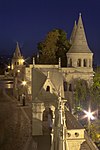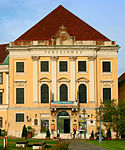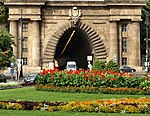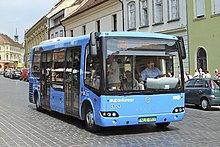Castle District (Budapest)

The Castle District ( Várnegyed in Hungarian ) next to the Castle Palace on Castle Hill in Budapest is one of the sights of the Hungarian capital. Although the castle district was almost completely destroyed twice, it has survived to the present day. The quarter emerged from the old city center of Buda, which stretches from the Wiener Tor (Hungarian: Bécsi kapu ) to the Szent György tér . The Vár Castle District is part of the 1st district of Budapest. Most of the buildings in the Burgviertel were built in the Baroque style.
history

As early as the 13th century, the Hungarians and their King Béla IV recognized the strategic importance of the 168-meter-high Inselberg, which extends in a wedge shape along the right bank of the Danube . Since the mountain was seen as the ideal place for the residence of the Hungarian king, a castle was started to be built on its southeastern tip, Buda Castle . At the same time, a civil town was built on the north-western side of the mountain. In the course of the Turkish Wars , large parts of the castle district were almost completely destroyed, but they were rebuilt in the Baroque style in the 17th and 18th centuries . For a second time, at the end of the Second World War , the castle district was on the verge of destruction. During the subsequent reconstruction, the medieval foundation walls and some interesting details such as the Gothic seating niches were found under many of the houses .
overview
Vienna Gate
The Wiener Tor ( Hungarian Bécsi kapu ) is one of the main entrances to the castle district. It is located on the site of the former Saturday Gate (Hungarian: Szombat kapu ).
It was built in 1936 on the occasion of the 250th anniversary of the liberation of Buda from the Turks (1686), which is commemorated by a plaque and statue on the inside of the gate. The plans for the building come from Jenö Lechner . Directly behind the gate is the square of the Wiener Tor (Hungarian: Bécsi kapu tér ), which used to be a market on Saturdays.
- Opposite the Wiener Tor, between Táncsics and Fortuna utca , is the Lutheran Church (Hungarian: Evangélikus templom ). It was built in 1895. Church concerts are held in the church all year round.
- The building of the Hungarian State Archives (Hungarian: Országos Levéltár ) can be found to the right of the Wiener Tor. The neo-Romanesque building was built between 1915 and 1918.
- The Anjou-Bastei (Hungarian: Anjou-bástya ) is located west of the Vienna Gate, behind the State Archives. It belongs to the north-western section of the castle fortifications and was fought over during the liberation struggles in 1686. At the second semicircular bulge of the bastion you can find a small memorial stone that the Hungarians dedicated in 1936 to the last Turkish pasha of Buda, Abdurrahman Abdi Pascha , who fell here in 1686.
Táncsics Mihály utca
The Táncsics Mihály utca leads from the Wiener Torplatz south to Dreifaltigkeitsplatz (Hungarian: Szentháromság tér ). The street was named after the Hungarian writer Mihály Táncsics . The street formerly known as Judengasse is one of the oldest on the Burgberg.
- In the Táncsics Mihály utca has Hungarian Landesdenkmalamt his seat where the works of the famous Hungarian builders and architects are represented.
- House number 7 in Táncsics Mihály utca is the seat of the Museum of Music History ( Zenetörténeti múzeum ). It was built between 1750 and 1769 according to plans by Matthäus Nepauer in the Baroque style. Among other things, musical instruments from various eras can be found here, including the instruments of an entire orchestra from the time of Joseph Haydn . There is also a special exhibition on the life and works of Béla Bartók . Concerts are occasionally given in the building.
- The life of the Jews in Hungary is shown in house number 26. This small house, built in the Gothic style, was once a Jewish prayer house (Hungarian: Középkori Zsidó Imaház ) which the small Jewish community based here had been using since the 14th century. In the courtyard of the house, parts of the synagogue built in 1461 are on display, the foundation walls of which were found during excavations in the garden of house no.
Between house numbers 17 and 23, along the north-eastern part of the fortifications, you get to the Mihály-Babits-Promenade (Hungarian: Babits Mihály sétány ). It extends in the north to the Wiener Tor. Below the promenade and the walls is the Europapark (Hungarian: Europa-liget ), which was created for the 100th anniversary of the unification of the cities of Buda and Pest .
Andreas-Hess-Platz
The Andreas-Hess-Platz (Hungarian: Hess András tér ) was named after the printer Andreas Hess . The first printed book in Hungary, the Chronica Hungarium , was written in his house No. 4 in 1437 .
- There is a statue in the square, created in 1936 by József Damkó . She represents Pope Innocent XI. to whom it was thanks that the Holy League against the Turks came into being in 1686 .
- The house with the red hedgehog above the gate (Hungarian: Vörös sün ház ), in the 17th / 18th centuries . Established in the 19th century, it was one of the oldest inns on the castle hill.
- Not far from Matthias Church is the Hotel Hilton , which opened in 1976 and was designed by Béla Pinter . Remnants of the medieval buildings were included in the construction concept. This included the remains of the former Dominican monastery that existed in Buda as early as the 13th century.
Trinity Square

Trinity Square (Hungarian: Szentháromság tér ) is the central square of the Castle District. It is limited to the north by the former building of the Ministry of Finance and to the east by the Matthias Church.
- In the center of the square is the Trinity Column (Hungarian: Szentháromság-szobor ), a Baroque plague column from the 18th century. It was designed in 1714 by Philipp Ungleich from Würzburg and is intended to keep the memory of the plague epidemic in 1691 alive. The column is 14 meters high. There is a trinity group at its head . The artist has placed several figures of saints at the foot of the column . The relief and the coat of arms on the pedestal were created by the sculptor Antal Hörbiger . On December 30, 1916, the newly crowned King Charles IV took the oath here. The plague column that stands today on Dreifaltigkeitsplatz is only a replica of the original monument, as it was badly damaged in World War II .
- The former town hall of Buda, a two-storey baroque building, is located on the corner of Szentháromság tér and Szentháromság utca . It is used by the Linguistic Institute of the Hungarian Academy of Sciences . The plans for the building were provided by the Italian builder Venerio Ceresola . It was built around 1700 using the remains of the medieval wall from the previous buildings. Ceresola united five Gothic houses behind a baroque facade. Mätthäus Nepauer added to the west wing in 1770. Under the corner bay is the statue of the Greek goddess Pallas Athene , who bears the coat of arms of Budapest on her shield. It was created by Carlo Adami around 1785.
One of the younger buildings on Trinity Street (Hungarian: Szentháromság utca ) is the house of the Ruszwurm confectionery (Hungarian: Ruszwurm cukrázda ). It has existed since 1827 and is still furnished in the old Empire style.
Fisherman's Bastion
On the north side of Matthias Church (Hungarian: Mátyás templom ) is the Fisherman's Bastion on the slope from the castle hill towards the Danube. It was built in 1895 on the site of Buda's medieval fish market. The building, built in neo-Romanesque style, serves as a viewing terrace with a view over the Danube and Pest. In front of the Fisherman's Bastion is the statue of St. Stephen, King .
Treasurer's Alley
The Treasurer's Alley (Hungarian: Tárnok utca ) stretches from Trinity Square to Place of Honor (Hungarian: Dísz tér ) and was once a typical trade route, which can still be seen in some houses. House no.14, with its facade painted with colorful geometric patterns, is an example of the Gothic trading houses that once stood here.
- The “Golden Eagle” pharmacy museum is located at Tárnok utca 18. It covers the history of modern pharmacy since the 16th and 17th centuries. Century. The building was built in the 15th century as a trading house. The pharmacy for the golden eagle (Hungarian: Arany Saspatika ) has been using the ground floor since the 18th century .
Place of honor
The place of honor (Hungarian: Dísz tér ) is located at the northern end of the castle district and was once the parade ground. In the Middle Ages, the square, framed by baroque and classicist buildings, was the market square of the castle district. Here is the Honvéd statue , which was erected here in 1893 by György Zala and is intended to commemorate the freedom struggles of 1848/1849.
Sankt-Georgs-Platz

The Sankt-Georgs-Platz (Hungarian: Szent György tér ) is located north of the castle palace and south of the place of honor (Hungarian: Dísz tér ), from which it is separated by the remains of the former Royal Hungarian Ministry of Honors . A large area with palace ruins from the 15th century was uncovered on the west side of the square, while the Burgtheater and the Palais Sándor are located on the east side of the square . At the east end of the square is the statue of the Turul bird , while the buildings of the castle-palace adjoin it to the south .
- In Színház utca which is Burgtheater ( Várszínház ). Originally a Carmelite monastery was located in the building complex , but this had to be closed in 1786 by a decree of the Austrian Emperor Joseph II . At that time, Farkas Kempelen was commissioned to convert the church and the convent building into a theater, where on October 15, 1790 the first stage play was performed in Hungarian.
- To the west of the Burgtheater are the remains of the former royal Honvédministeriums . Since the Battle of Budapest in the winter of 1944/45, only the ground floor of the building, which was erected between 1879 and 1881 and which was once a splendid facade, has been preserved. Today a museum on the history of the Hungarian army is set up here. On December 30, 1916, the newly crowned King Charles IV. Took place on the square in front of the Honvéd Ministry on the coronation hill, which had been specially built for this purpose.
- South of the Burgtheater is the Palais Sándor ( Sándor-palota ). The neo-classical building was designed in 1806 by Mihály Pollack for Count Vincent Sándor . Since 2003 the palace has been the seat of the Hungarian President . The uncovered foundations of the Gothic church can be seen on the green area west of the Palais Sándor.
- The statue of the Turul bird, which is erected at the eastern end of the square, sits on a stone with wings wide open and carries a sword in its claws. The mythical creature resembles both an eagle and a falcon. The name comes from Turkish . This figure plays a major role in the history of the Hungarians. According to a legend, a Turul is said to have impregnated Emese in his sleep in 819 and prophesied in a dream that she would give birth to a son who would be the ancestor of many kings.
Herrengasse
The Herrengasse (Hungarian: Úri utca ) is in the immediate vicinity of the castle palace . The history of Herrengasse goes back to the 13th century. At the turn of the 14th to 15th centuries, the Hungarian nobles and wealthy merchants had their townhouses built here. The street is mainly characterized by buildings in the Romanesque, Gothic and Baroque styles. In the later Turkish wars, large parts of the street and its buildings were destroyed. Most of the new buildings were built in the baroque and classical style.
- The history of Hungarian telecommunication technology can be seen in house number 49 in Úri utca , where the Hungarian Telephone Museum is located.
- At the northern end of Úri utca is the west tower of the former Maria Magdalene Church ( Mária Magdolna-templon ). Both the 13th and 15th century church and the tower were almost completely destroyed in World War II. Later it was decided to demolish the church and to reconstruct the tower.
Kapisztrán Square
Kapisztrán Square (Hungarian: Kapisztrán tér ) is located in the north-west of the castle district and was named after the Italian Franciscan Johannes Capistranus . In 1922 József Damkó erected a monument in his honor on the square.
- On the north side is the War History Museum (Hungarian: Hadtörténeti Múzeum ). Among other things, exhibits and documents on Hungarian war history since the 16th century are on display here. However, the focus of the exhibition is on developments since 1848. The War History Museum building once belonged to Ferdinand's barracks .
Parliament Street
Parliament Street (Hungarian: Országház utca ) begins on the south side of Kapisztrán Square and is the main street of the Castle District.
Fortunastrasse
The Fortuna street (Hungarian: Fortuna utca ) meets at the Matthias Church on the Országház utca . In the Middle Ages, mainly French craftsmen lived here who were involved in the construction of the castle palace.
- The Museum of Commerce and Catering is located at Fortuna utca 4 . Here you can see an establishment of a Buda confectionery from 1870 and various poster advertisements from past decades.
Cave system
There is a cave system under the castle palace . In times of war this was repeatedly used by the Buda population as a shelter and storage room. Among other things, the remains of old wells and an old command post of the German Wehrmacht from the Second World War can be seen here .
gallery
Equestrian statue of Stephan I.
Transport links
The castle district is in a number of ways with the public transport of Budapesti Közlekedési központ distance (BKK):
Buses 16, 16A, 16B and 116 connect the castle district with the underground stations at Széll Kálmán tér (1951–2011 Moszkva tér ; M2 and trams 4, 6, 17, 56 (A), 59 (A / B) , 61) and at Deák Ferenc tér (M1, M2, M3, tram 47 (B), 48, 49) and the tram stop at Clark Ádám tér (tram 19, 41).
The Budavári Sikló , a funicular railway that connects Clark Ádám tér directly with Szent György tér, has also existed since 1869 .
(As of March 2020)
literature
- The Buda Castle Hill (Várhegy) . In: Anneliese Keilhauer. Hungary, culture and art in the land of the Magyars . DuMont art travel guide. 3. Edition. DuMont Buchverlag, Cologne 1996, ISBN 3-7701-2096-5
Web links
Individual evidence
- ^ Janos Hauszmann: Brief History of Budapest . Pustet, Regensburg 2012, ISBN 978-3-7917-2454-6 , p. 67.
- ↑ Anneliese Keilhauer: The castle hill (Várhegy) of Buda . In: Hungary, culture and art in the land of the Magyars . 3. Edition. DuMont Buchverlag, Cologne 1996, ISBN 3-7701-2096-5 .
- ↑ Mária Vida: The Pharmacy Museum "Golden Eagle" in the Buda Castle District. Pharmacy in the Renaissance and Baroque. In: From the history of medicine. Edited by the Museum, Library and Archive for the History of Medicine “Ignác Semmelweis” and the Hungarian Society for the History of Medicine (MOTESZ). 2nd Edition. Budapest 1984 (= Orvostörténeti közlemények. Communicationes de historia artis medicinae , Supplement 13-14), pp. 85-93.
